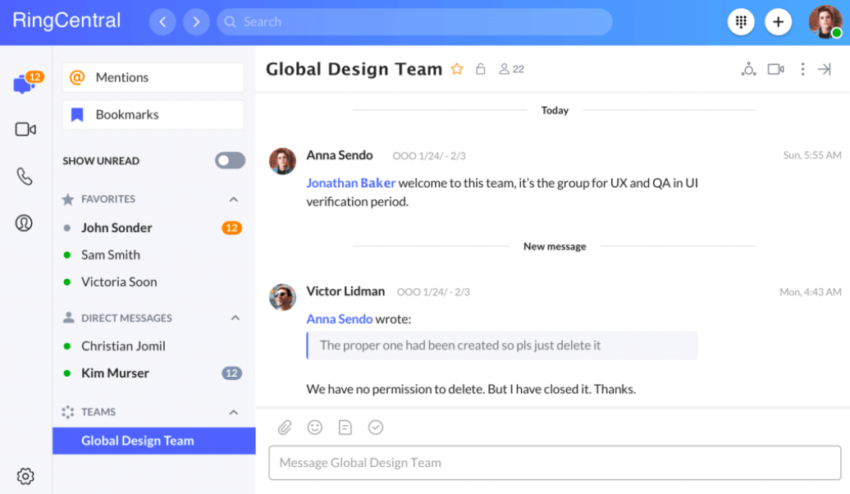PBX (private branch exchange) was revolutionary for its time. It was the diamond jewel of communications systems—the first-ever business phone system for routing and hosting both internal and external calls.
But that time is long gone.
Today, PBX is an outdated phrase and, for the most part, an outdated system, as more modern and innovative communications systems have taken its place, such as VoIP (voice over internet protocol) and UCaaS (unified communications as a service).
So… you may be thinking that PBX is all but forgotten, but it hasn’t necessarily been kicked to the curb by business owners and leaders.
With that being said, it has evolved, and in the rest of this article, we’re going to explore the evolution of PBX to learn about its history and various phases.
Why? Because understanding PBX is vital to understanding where we are today, with elite UCaaS providers like RingCentral. (Yes, we said that, and we can prove it.)
Here’s what we’ll cover:
- What PBX is: An overview
- How a PBX system works
- Who uses PBX systems
- How the PBX system has evolved
- The differences between PBX, VoIP, and UCaaS
- PBX phone system costs: A comparison
What PBX is: An overview
A PBX telephone service refers to a private phone network used by a business or organization. It allows users to communicate internally (within their company) and externally (with partners and clients). The telephone system connects calls between users within the PBX on local lines and lets them share a single external phone line through which the company can be contacted. So if you call a company’s phone number and use an extension number to contact Susan in customer service, then you are using that company’s PBX.
How a PBX system works
Several components make up a traditional PBX system.
- The system includes a CPU (central processing unit) that controls call switching, call logging and routing, and connecting and disconnecting.
- A power supply module gives the phone system the power it needs. Its capacity depends on the number of extension lines.
- Line cards are used to increase the number of extension lines in the system.
- The operator console controls incoming calls and routes them to the appropriate extension through minimal human intervention.
- Trunk lines are the PBX’s way of connecting to lines outside a building.
Who uses PBX systems
The truth is, many companies across all industries use PBX systems (or something similar). Companies thrive on communication, and business isn’t possible without an open line of dialogue. Therefore, it really doesn’t matter whether it’s a law firm, a car dealership, or a pharmaceutical company—each of them requires seamless communication with both internal and external people, and requires a PBX, VoIP, or UCaaS system.
How the PBX system has evolved
Back in the day, when someone called a business (aka when a business received an inbound call), a human operator or receptionist from outside the company would need to manually connect the call to the relevant person using cords and a switchboard.
In the 1960s, the first iterations of PBX were introduced as a way for employees to make calls within their office or connect to others outside of it without having to go through a receptionist. Ultimately, it was a way to reduce costs by making internal and external company phone communications more effective.
By the 1990s, as the internet and computer technology experienced major advancements, so did telephone systems. After integrating with computers, internet connections were eventually incorporated into telephone systems. Today, PBX systems have a multitude of complex features including call forwarding, voicemail, missed call email notifications, call recording, extension dialing, and mobility.
The rise of VoIP systems
As the internet took hold of businesses and their operations in the 1990s, we began to see a merge between communication and the worldwide web.
Not long after, voice over internet protocol, aka VoIP, was born.
VoIP, in short, is making calls over the internet. It’s the technology that allows people to make voice calls over IP networks in real time, at any time. VoIP is a set of telephony protocols that work through packet switching, which allows digital voice data to travel across different networks like the internet. With this technology, computer networks are able to function similarly to traditional networks and can also be used like a regular landline.
But VoIP systems alone don’t account for the evolution of PBX, as the rise of instant messaging and its role in business would come along to change the face of business communications forever.
Where we are today: An intro to UCaaS
The very seed planted by PBX systems has now grown into something much more vast and varied in its capabilities. That “something” is referred to as UCaaS, aka unified communications as a service.
UCaaS is what we provide here at RingCentral.
Unified communications as a service (UCaaS) provides a cloud-based business communications system across multiple channels and devices. UCaaS combines phone service, video conferencing, team messaging, SMS, fax, and other communications tools on a single integrated cloud platform. It is designed to be accessed from any device—desktops, laptop/tablets, or mobile phones, and, as you can imagine, greatly helps businesses become more effective and efficient with their communication.
The differences between PBX, VoIP, and UCaaS
As you can see, the original PBX business-phone system has undergone quite the transformation over the course of 5+ decades.
But what does that transformation look like in detail? What are the true differences between PBX, VoIP, and UCaaS? And what do you stand to gain from one that you might not get from another?
Let’s take a look.
PBX
A PBX system is compiled of direct-to-line connections that are made possible by an exchange. With a switchboard, a PBX system routes a call until it reaches its target recipient.
Note the word “switchboard,” which indicates the physical hardware involved in a PBX system—a major difference from VoIP and UCaaS.
For businesses, the prime advantage of a PBX phone system is that it provides you with the opportunity to have fewer phone lines, as employees can have their own extension numbers with a PBX system. Plus, PBX phone systems allow employees to host their work phones on the same network, making internal calls both easy and free to make.
VoIP
A VoIP system, unlike a PBX one, relies on the internet. It works by sending and receiving voice communications over an IP network.
With a VoIP phone service, analog audio like human voice is converted into a digital format that’s transmitted over the internet in real time, mimicking traditional telephone services and calls. In other words, though your verbal conversation is taking place over the internet, it still feels and sounds the same. The means of transporting your voice are just different.
Additionally, VoIP systems are, for the most part nowadays, cloud-based platforms. This means that you don’t have to incur additional hardware costs like servers or PBX systems to host calls. All you need is an internet connection in order to talk shop with both clients and colleagues.
UCaaS
Where PBX and VoIP systems are applicable for voice-only communications, UCaaS covers all communication channels and devices.
UCaaS is a cloud-based business communications system that combines phone service, video conferencing, team messaging, SMS, fax, and just about any other communication tool on a single integrated cloud platform:
Another great feature about a unified-communications-as-a-service system is that it can be accessed from any device connected to it—from desktops to laptops/tablets and mobile phones.
The benefits of UCaaS
There are several wide-ranging benefits of UCaaS. Not only does a UCaaS system improve productivity and communication efficiencies, but it also boasts serious economic value, flexibility, ease of use, and security.
- It’s more cost-effective
- With UCaaS, you don’t have to build or rent additional space for communications hardware, as everything is on the cloud. Plus, you don’t have to hire an IT vendor or team, as the UCaaS provider will service your technology whenever you need them, in addition to whatever maintenance plan you have in place.
- It’s scalable
- If built to scale globally, your UCaaS system can support you and your team wherever you are across the world. Being cloud-based, it’s incredibly easy to add phone lines and features for new/traveling employees and new offices:
- It’s easy to use
- UCaaS is designed for the modern-day worker and the modern-day company, and it’s especially useful for today’s growing distributed workforces. Mobile-friendly with global capabilities, UCaaS allows you to operate your business smoothly, even with a fully remote workforce scattered around the world.
- It’s secure
- The best UCaaS providers incorporate network security technologies—in addition to data encryption, HIPAA-compliance, protected file protection, and more—to make sure your company’s data, information, and communications are safe and secure. See how Dentistry for Kids & Adults uses a UCaaS platform to provide a great client experience.
PBX phone system costs: A comparison
Your investment in a PBX phone system all depends on what you’re looking for in a communications system for your company. It also depends on your bottom line, your budget for the fiscal year, and your cost-cutting goals.
The older, more traditional PBX phone systems come with expensive hardware, while the modern-day cloud-based VoIP systems carry hardly any hardware costs at all. That being said, an investment in a cloud-based system like VoIP should be preceded by a company-wide investment and adoption of the systems needed to successfully host and operate a VoIP system.
Therefore, some of the costs of each tend to offset each other. You’ll pay a higher price for the hardware of the older PBX systems, but you’ll have to make investments in a broader range of technologies for the modern-day VoIP and UCaaS systems. It all comes down to what you’re looking for to help revolutionize your company’s communications.
Prepare your business for the future with RingCentral UCaaS
Although PBX and VoIP systems are adequate solutions, nothing comes close to the wide-ranging benefits of one of today’s leading UCaaS systems like RingCentral Office.
Complete with phone, video, and messaging capabilities, RingCentral Office is unified communications like you’ve never seen before. Here are some of the top features of our solution:
- It’s reliable
- Our industry-leading 99.999% uptime SLA means our carrier-grade infrastructure works day and night to keep you online, all the time.
- It’s global
- RingCentral Office allows you to manage teams in over 40 countries from just about anywhere. You also get one bill in your local currency to keep things simple.
- It’s secure
- You can protect your data at every level of your business. Plus, our built-in security encrypts conversations between all endpoints.
Originally published Dec 10, 2020, updated Jun 19, 2024






